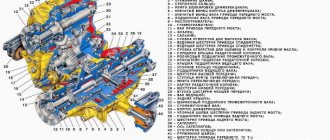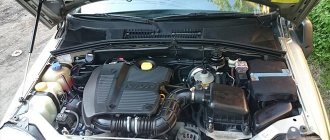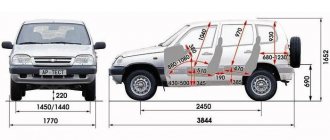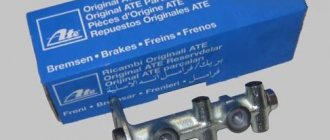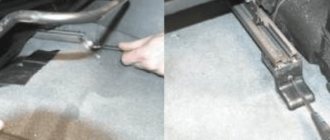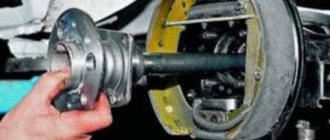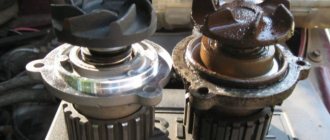The engine force, which is converted into the gearbox, is transmitted to the drive axles of the Chevrolet Niva not directly, but through the transfer case. It performs several functions:
- Distributes torque between axles, allowing them to rotate at different speeds.
- If necessary, it blocks the center differential, preventing wheel slipping.
- Allows you to change the gear ratio, increasing torque.
This key transmission element ensures high maneuverability on difficult road sections.
Device
The VAZ 2123 transfer case is installed at the rear of the gearbox and is attached with brackets to the bottom of the car. It is driven by an intermediate shaft. Torque from the drive shaft to the drive axles is transmitted by cardans, which are screwed to the flanges of the transfer case drive shafts.
The transfer case body is made of aluminum alloy. In its upper part there is a hatch with a lid.
The transfer case consists of the following parts:
- RK Corps.
- Drive shaft.
- Control levers.
- Bearings.
- Gears.
- Drive shafts (front and rear).
- Flanges.
- Differential mechanism housing.
- Axles.
- Satellites.
- Clutches for gear shifts and differential locks.
- Oil seals.
- Retaining and thrust rings.
- Housing covers.
- Breather.
The Chevy Niva transfer case has three speeds:
- The first one, with a gear ratio of 1.2.
- Neutral.
- Low (second), with a gear ratio of 2.135.
Neutral allows you to temporarily disengage the gearbox from the transmission. It is used when connecting a winch and other units to a vehicle.
The first speed is intended for on-road driving, and the second is for off-road use where high torque at low speed is required.
Important: there are no synchronizers in the transfer case. Therefore, it is necessary to switch the locking and speed of the RC only after stopping the machine. If you cannot switch the transfer case, you need to try turning the steering wheel or moving slowly. In this case, the gears will change their relative position, which will make it possible to switch the mode.
A few words about the Chevrolet Niva transfer case
I think it’s time to talk about the transfer case of the Chevy Niva, because those who just bought this car, at the very beginning of use, do not really know how to use the transfer case, what the rules are, and in general, when to lower the gear and when to lock it. Let's figure it out now. It’s a pity, of course, that I didn’t record a video on today’s drive along a fairly washed-out road. Well, never mind, I’ll record it and show it clearly on video. For now, in words.
In general, the transfer case switches to a lower gear, as well as to lock, and it is possible and even necessary to do this at the same time. It’s convenient on the Shevik - this is done with one lever.
Turn it down - right up. Add lock - Pull the lever all the way to the left. Look at the switch handle, it's written there. Letter designation - L(low) - low, N - neutral, H(high) - high, that is, normal.
How inter-axle locking works - read this article. There you will also learn about self-blocks - a real cool upgrade for the Chevrolet Niva, which will allow you to drive even further.
Well, now we’ll figure out when it’s better to turn it down, and when to also lock it. And how to do it correctly.
It looks something like this - we are driving across the field in normal second/third gear. Suddenly there is a terrible puddle ahead. We stop and turn down the car.
This is the first rule - when you engage the lower gear, you must definitely stop, that’s how the Shevik differential is designed. But the lock can be turned on and off without stopping. But do you need to always enable the blocking? It’s an interesting question and I’ll tell you what - I use it in exceptional cases, when the dirt is not out of the blue, but there are all sorts of potholes and where there is a risk of catching the “diagonal”.
You may ask - how long does it take to turn on the blocking and then turn it off? There is another nuance here - very often, many owners of the Chevrolet Niva have a problem with the blocking - it does not turn off. It just jams and that’s it, you have to drive on the highway with the blockage. This, you understand, is very harmful for the machine and in such cases you must turn it off.
How to turn off the interaxle? There are several options - turn on reverse, accelerate a little and try to dislodge the lock while driving. You need to do this at speed; it works quite often. Moreover, you can accelerate forward and also try to turn off the lock. I also got stuck once, but even then I didn’t notice it right away and it’s not a problem. Therefore, look at the on-board computer - when the lock is turned on, the following combination will “burn”:
In bright sunny weather it is sometimes difficult to see. Be careful. Well, about turning off the center wheel - I managed to turn it off just when reversing. Needless to say, now I turn it on only in the most dire cases. In the rest of the others, lower gears are quite enough for me.
Just today I went to the lake to check if the ice had melted. The road was washed out, the snow had already melted and turned into liquid mud, and it’s not safe to drive through such mud on my AT tires. It feels like it’s being dragged in all directions, but the most important thing is that I’m driving, I don’t get stuck, and sometimes the ruts were almost to the very bottom; when you shuffle, it always becomes unpleasant)) After some short drives, the car looked “military-like” - all covered in mud , went to the city - people look around))
And here’s another observation of mine: it’s better to drive through mud slowly but surely. This applies to lower gears - if the mud is serious, then I always drive in first, pushing hard, trying to feel the wheels spinning in the mud. If you accelerate a little, you can immediately “burrow”, this is the case when there is no hard covering under the liquid mud. This happens when driving through spring fields. That’s why it’s better to do it slowly, at first. Operate the pedal, don’t accelerate, feel how the car is really “rushing” - at first it feels great.
Well, a lot, of course, depends on the tires. Sometimes, if the tires are toothy, it is useful to accelerate so that the tread cleans itself. For Nivka and Shevik I highly recommend Cordiant Offroad tires, and if you have a little more money, then imported ones - Kumho and of course Hankuk Dinapro MT. Imported tires are more comfortable and are better for driving on the highway because they are soft. Well, in terms of cross-country ability, everything is also very cool here - after all, the tires are a Mud Terrain class, which means they are simply designed for mud.
When you turn on the second lower gear, the car accelerates, but if you get into a mud hole, there is a risk that the engine will “choke” (it is very difficult to spin the wheels in the second gear when stuck) and you will stall. Needless to say, stalling in a deep puddle can be dangerous. Therefore, if you decide to overcome a puddle or muddy area with acceleration (very often this makes sense), then be prepared in the middle, if you suddenly start to fall through, immediately switch from 2 to 1 low, so as not to stall.
All this knowledge - when to go in first and when in second, when to turn on the lock and when not necessary - all this comes with experience. You’ll ride in the mud and you’ll already begin to understand that it’s better to take the puddle over there with acceleration without locking, and that clay hill with potholes - only at 1 lower gear and with the locking on. Think with your head first, and don’t rely on the car to pull it out. The Chevrolet Niva is an excellent car, if you don’t be stupid.
I remember when we were making our way to an abandoned village, we got to one really dangerous place, and there was a UAZ standing there and didn’t dare to drive through. We scouted around and decided that we would pass. And we drove by, leisurely, pushing hard, without particularly accelerating.
Therefore, one more rule (which I always adhere to) - if the place is dangerous, there is a risk of getting stuck, then get out of the car, poke it with a branch, find out the depth of the puddle, rut, feel for a solid place where you can drive. This is the job of the navigator, so let your partner get out of the car and don’t be lazy. Spend 5 minutes on reconnaissance so that you don’t have to spend several hours later getting out of an ambush.
Common faults
Car owners most often note the following problems with the Republic of Kazakhstan:
- Difficulty shifting gears.
- Inability to engage differential lock.
- Increased vibration when starting or driving the car.
- Oil leak.
If any of these problems are identified, you must contact a service station or repair the transfer case yourself. In some cases, it is enough to adjust the steering wheel or treat the control drive joint with WD-40.
Rules for applying blocking on Niva
To ensure that the locking mechanism lasts for a long time, use the following rules:
- It is necessary to switch the transfer case when the Niva does not move.
- The differential can also be engaged while the vehicle is moving.
- To ensure efficient and long-term operation of the device, it is advisable for the Niva driver to turn on the lock from time to time. Once a week in winter is enough.
And also interesting: Niva Lynx 1 Bronto. Mos BRONTO: Moscow, St. Petersburg, Nizhny Novgorod, Rostov, Tula, Yaroslavl, Minsk, Mogilev, Grodno.
Where is the lever responsible for switching located? Pay attention to the area between the wings located in front, there are 2 levers there. One makes it possible to change gears at the gearbox, the other successfully controls the transfer case.
The basis of the transfer case is a gearbox, which includes 2 stages. The control lever comes directly from it, you can move it forward and backward - this is how the gear is changed on the Niva. The direction of movement of the lever to the left and right allows you to activate the differential lock and vice versa to disable it.
How to use it correctly?
There is a diagram on the shift lever. To engage a downshift, you need to move the lever to the right, up. To lock the differential, pull it all the way to the left. There are also Latin letters on the lever. So, L is a low gear, N is neutral, and H is high. Now let's find out how to use all this so that we don't have to repair the mechanism and change the transfer case bearings.
Gear Modes
Let's take a closer look at how to use the transfer case on a Chevrolet Niva. It serves to switch to a lower gear and also blocks the center differential; this can be done at the same time. In order to engage a lower gear, you need to shift the lever to the right and up; to lock the lever, you need to pull it to the left all the way. The handle has the following designation:
- Low(L) - decrease;
- N-neutral;
- High(H) - normal, increased.
You can switch the transfer case from low to high while driving. To do this, you need to squeeze the clutch twice.
Low gear is engaged at a speed of no more than 5 kilometers per hour, or after a complete stop. In order to overcome a steep climb, or when driving where there is soft ground, so that the vehicle speed is minimal and at the same time stable, a lower gear must be engaged in advance. For example, if you are driving on a flat road in second or third gear, and a bad section of road appears in front of you, you need to stop and shift to a lower gear.
It is not recommended to turn on the center differential at high speed, since the car may skid strongly at the moment of switching. It is advisable to block where there is a slippery surface and the wheels begin to slip.
These include:
- Switching the transfer case should only be done when the car is not moving.
- You can also engage the differential while the vehicle is moving.
- You can switch to a lower gear while the car is moving.
- To ensure long-term and uninterrupted operation of the differential, it is necessary to periodically turn it on, especially in winter. This should be done once every 7 days.
Also interesting: Tuning Niva 2121 with your own hands: body, interior, suspension
Among domestic car enthusiasts, the Chevrolet Niva is a fairly popular SUV that appeals not only to fans of extreme driving, but also to fans of measured driving outside the city. Many people know that one of the features of a car of this brand is the presence of a transfer case in it.
Using this unit, you can enable downshifting, locking, or two functions at the same time, depending on the conditions. The question of how the Niva Chevrolet transfer case should be used correctly is of interest to many happy owners of such a vehicle and those who only intend to purchase it.
It should be immediately noted that you can engage both the lock and the transmission at the same time using the Chevrolet lever that changes gears. So, the lever shifts to the right, and then immediately up to engage a lower gear. To switch back to higher, the lever should simply be moved back.
Using a Niva Chevrolet transfer case, in addition to the above, neutral gear is also engaged, while the car will remain reliably in one place. The lock can be engaged at any time - in normal gear, in low gear - just switch the Chevrolet lever to the left.
This mechanism can operate in five modes:
- Neutral is on.
- The differential is unlocked when the "lowering" is turned off. In this case, the torque is distributed in a ratio of one to two.
- The differential is locked when overdrive is engaged. Here, torque distribution is carried out automatically, depending on the quality of wheel grip on the road.
- Downshift is engaged and the differential lock is disabled. The transfer of forces occurs in the same ratio as in the first case.
- The differential is locked and the gearbox is engaged. In this case, all axles are rigidly locked together, including the axle shafts. Torque is produced unevenly, depending on the type of road surface (dirt, sand, etc.). In this mode of operation, the best cross-country ability of the vehicle is achieved. But driving with a constantly engaged downshift and with locks will not work. This increases the load on the transfer case bearings. The Chevrolet Niva will soon require serious intervention in the transmission. Fuel consumption also increases significantly, which greatly eats up the tires.
Transfer case purpose
If you create a permanent all-wheel drive in a car and provide constant torque on the driveshafts of the rear and front axles, then such equipment is capable of overcoming obstacles such as off-road, but no more. However, the car will not be suitable for driving on the highway at relatively high speeds.
- There will be an excessive load on the parts that distribute the moment along the axes.
- Fuel consumption will increase.
- There will be a rubber eating effect.
The transfer case on a Chevrolet Niva car performs two functions at once. It ensures the distribution of torque along the axes with the possibility of supplying it to both axles simultaneously.
The transfer case also converts torque, increasing it by lowering the speed in gear. Here, transmission means a pair of gears that are in mesh and have a certain gear ratio. These two functions can be performed together or separately.
Overcoming a deep puddle
Often a dispute arises between motorists about how best to cross a ford with a transfer case. Some people prefer to “fly” into a puddle from acceleration, others prefer to downshift. If you get into a mud pit, there is a high risk of water hammer - water gets into the cylinders through the filter, and the engine “chokes.” To exclude this, many install a special snorkel. But you can do without it. A deep puddle should be overcome in second low gear. This is done so that in case of trouble (when the car starts to fail) you can switch to first gear in time and not stall. If you enter the water from acceleration (which is a better decision), remember that the wheels may get stuck in the middle of the journey. The engine power is not enough to turn the wheels - the car stalls, and the engine experiences a hydraulic shock.
Other problems
Quite often, car owners do not know how to use the transfer case on a Niva, and may encounter the fact that the center lock does not turn off, and they have to drive along the highway in this mode, which negatively affects the car. In order to switch the transmission to normal mode, you need to switch to reverse gear and accelerate a little, and while reversing, try to dislodge the lock. If this doesn't work, you can try to do the same thing, only while moving forward.
To avoid transmission problems, Niva car owners must adhere to the following rules:
- Try not to change gears while slipping;
- If the lock switches with difficulty, there is no need to apply excessive force;
- When a difficult-to-pass section has been overcome, it is necessary to unlock it again, since on a flat road in this mode at high speeds the car’s controllability deteriorates, and the service life of the entire transmission decreases.
Here are the basic rules by following which you can significantly extend the life of the gearbox on a Chevrolet Niva.
Sometimes there is a knocking sound in the transfer case. The Chevrolet Niva is a more reliable car than the VAZ-2121, but such malfunctions should not be ruled out. The first thing you should pay attention to is the driveline. Previously, Nivas had crosses, the play in which caused a lot of noise and vibration.
https://www.youtube.com/watch?v=4k93vmooYNM
During the operation of off-road vehicles, parts and components of the transfer case gradually become unusable due to wear. Most often, the following interruptions in the operation of the mechanism occur:
- The front axle does not engage.
- The transfer case is overheating.
- Leaks and increased oil consumption of the transfer case.
- Unauthorized disabling of the front axle.
Transfer case control
The key to long-term operation of the transmission is the correct choice of its operating mode. Each owner of a Niva Chevrolet car can first become familiar with the operating rules using a specially developed manual. First of all, you need to understand the operating modes of the transfer case and their activation. On Chevrolet Niva cars, the downshift/upshift, as well as the locking, are activated by one lever, which has five positions.
- Central position – neutral is on.
- Back and to the right - high gear with the differential unlocked.
- Back and to the left - high gear with a locked differential.
- Forward and to the right - low gear with the differential unlocked.
- Forward and left - low gear with a locked differential.
Why enable blocking?
An SUV is a car that is not afraid of difficulties. Chevy Niva is an all-wheel drive car. The presence of a lock allows it to become an even more powerful and reliable off-road friend. When you turn on the lock, those wheels that are easier to work with work.
When you turn on the lock
As a rule, both axles work at 50%, that is, one wheel on the front axle and one on the rear axle work.
For example, the question of how to use the transfer case on a Chevrolet Niva is relevant when your car begins to slip even when the lock is turned off. In this case, those wheels that are stuck are slipping and as a result they get buried even more. When the lock is turned on, those wheels that have not skidded begin to work and thereby pull the car out of the mud or ice surface.

